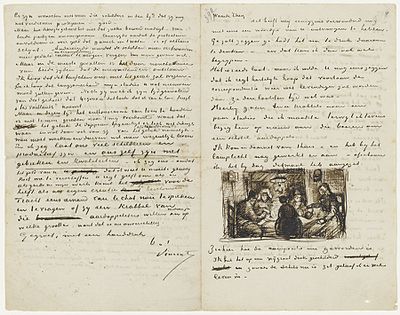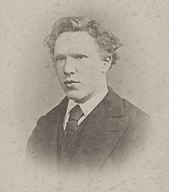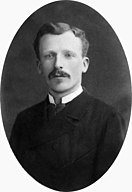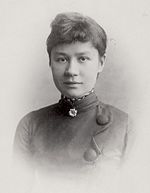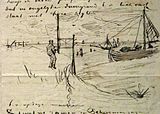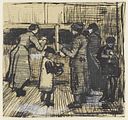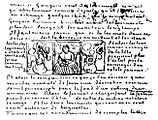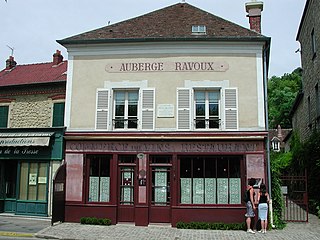
Vincent Willem van Gogh was a Dutch Post-Impressionist painter who is among the most famous and influential figures in the history of Western art. In just over a decade he created approximately 2100 artworks, including around 860 oil paintings, most of them in the last two years of his life. They include landscapes, still lifes, portraits and self-portraits, and are characterised by bold, symbolic colours, and dramatic, impulsive and highly expressive brushwork that contributed to the foundations of modern art. Only one of his paintings was known by name to have been sold during his lifetime. Van Gogh became famous after his suicide, aged 37, which followed years of poverty and mental illness.
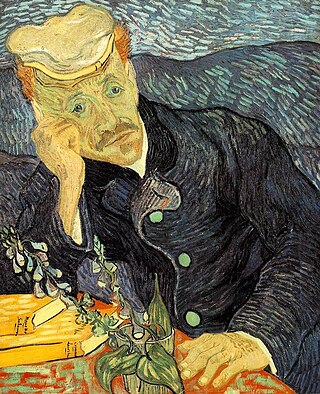
Portrait of Dr. Gachet is one of the most revered paintings by the Dutch artist Vincent van Gogh. It depicts Dr. Paul Gachet, a homeopathic doctor and artist with whom van Gogh resided following a spell in an asylum at Saint-Rémy-de-Provence. Gachet took care of Van Gogh during the final months of his life. There are two authenticated versions of the portrait, both painted in June 1890 at Auvers-sur-Oise. Both show Gachet sitting at a table and leaning his head on his right arm, but they are easily differentiated in color and style. There is also an etching.
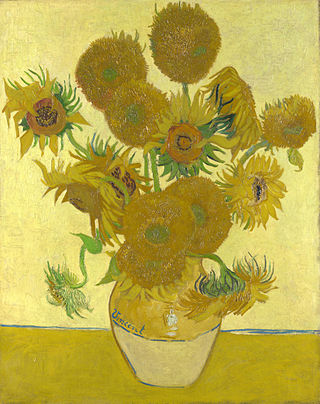
Sunflowers is the title of two series of still life paintings by the Dutch painter Vincent van Gogh. The first series, executed in Paris in 1887, depicts the flowers lying on the ground, while the second set, made a year later in Arles, shows a bouquet of sunflowers in a vase. In the artist's mind, both sets were linked by the name of his friend Paul Gauguin, who acquired two of the Paris versions. About eight months later, Van Gogh hoped to welcome and impress Gauguin again with Sunflowers, now part of the painted Décoration for the Yellow House that he prepared for the guestroom of his home in Arles, where Gauguin was supposed to stay. After Gauguin's departure, Van Gogh imagined the two major versions as wings of the Berceuse Triptych, and finally, he included them in his Les XX in Bruxelles exhibit. Apparent symmetry of F454 :

Theodorus van Gogh was a Dutch art dealer, the younger brother of Vincent van Gogh. Theo's unfailing financial and emotional support allowed his brother to devote himself entirely to painting. Theo died at the age of 33, six months after his brother died at the age of 37. At his death Theo owned practically all of his brother's artwork. Theo's widow Johanna van Gogh-Bonger worked tirelessly to promote the work of Vincent and keep the memory of her husband alive. Theo made a significant impact on the art world as an art dealer, playing a crucial role in the introduction of contemporary French art to the public. His widow was able to draw on the connections that Theo made to promote Vincent's work. In 1914, she reburied Theo's remains next to Vincent's.

L'Arlésienne, L'Arlésienne : Madame Ginoux, or Portrait of Madame Ginoux is the title given to a group of six similar paintings by Vincent van Gogh, painted in Arles, November 1888, and in Saint-Rémy, February 1890. L'Arlésienne means literally "the woman from Arles".
Vincent van Gogh lived during the Impressionist era. With the development of photography, painters and artists turned to conveying the feeling and ideas behind people, places, and things rather than trying to imitate their physical forms. Impressionist artists did this by emphasizing certain hues, using vigorous brushstrokes, and paying attention to highlighting. Vincent van Gogh implemented this ideology to pursue his goal of depicting his own feelings toward and involvement with his subjects. Van Gogh's portraiture focuses on color and brushstrokes to demonstrate their inner qualities and Van Gogh's own relationship with them.
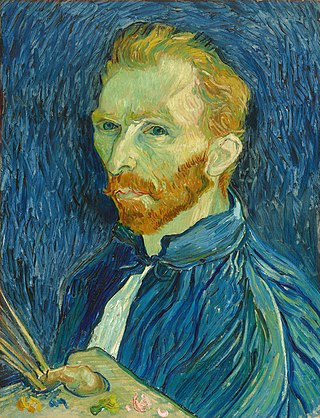
This is a chronology of the artist Vincent van Gogh. It is based as far as possible on Van Gogh's correspondence. However, it has only been possible to construct the chronology by drawing on additional sources. Most of his letters are not dated and it was only in 1973 that a sufficient dating was established by Jan Hulsker, subsequently revised by Ronald Pickvance and marginally corrected by others. Many other relevant dates in the chronology derive from the biographies of his brother Theo, his uncle and godfather Cent, his friends Émile Bernard and Paul Gauguin, and others.
The fame of Vincent van Gogh began to spread in France and Belgium during the last year of his life, and in the years after his death in the Netherlands and Germany. His friendship with his younger brother Theo was documented in numerous letters they exchanged from August 1872 onwards. The letters were published in three volumes in 1914 by Johanna van Gogh-Bonger, Theo's widow, who also generously supported most of the early Van Gogh exhibitions with loans from the artist's estate. Publication of the letters helped spread the compelling mystique of Vincent van Gogh, the intense and dedicated painter who died young, throughout Europe and the rest of the world.
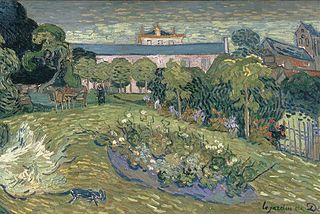
Daubigny's Garden, painted three times by Vincent van Gogh, depicts the enclosed garden of Charles-François Daubigny, a painter whom Van Gogh admired throughout his life.
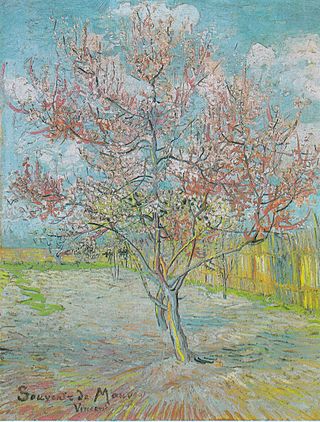
Flowering Orchards is a series of paintings which Dutch artist Vincent van Gogh executed in Arles, in southern France in the spring of 1888. Van Gogh arrived in Arles in February 1888 in a snowstorm; within two weeks the weather changed and the fruit trees were in blossom. Appreciating the symbolism of rebirth, Van Gogh worked with optimism and zeal on about fourteen paintings of flowering trees in the early spring. He also made paintings of flowering trees in Saint-Rémy the following year, in 1889.

Girl in White was painted by Vincent van Gogh in 1890 in Auvers-sur-Oise, France, during the last months of his life. Girl in White has been part of the Chester Dale Collection in the National Gallery of Art, Washington D.C. since 1963.

Wheat Fields is a series of dozens of paintings by Dutch Post-Impressionist artist Vincent van Gogh, borne out of his religious studies and sermons, connection to nature, appreciation of manual laborers and desire to provide a means of offering comfort to others. The wheat field works demonstrate his progression as an artist from the drab Wheat Sheaves made in 1885 in the Netherlands to the colorful and dramatic 1888–1890 paintings from Arles, Saint-Rémy and Auvers-sur-Oise in rural France.

The death of Vincent van Gogh, the Dutch post-Impressionist painter, occurred in the early morning of 29 July 1890, in his room at the Auberge Ravoux in the village of Auvers-sur-Oise in northern France. Two days earlier, Van Gogh shot himself.

Old Vineyard with Peasant Woman is a watercolour painting by Vincent van Gogh that he made in May 1890 when he lived in Auvers-sur-Oise, France.

Enclosed Field with Peasant is an oil painting by Dutch artist Vincent van Gogh, painted around 12 October 1889. The Size 30 painting, measuring 73 cm × 92 cm, depicts a scene of a ploughed field near the asylum at Saint-Rémy-de-Provence, with a lilac bush, a peasant carrying a wheatsheaf, several buildings, and the Alpilles mountains rising behind, with a small patch of sky. Van Gogh considered it a pendant painting to The Reaper executed earlier in 1889. It is currently part of the permanent collection at the Indianapolis Museum of Art.

Memory of the Garden at Etten (Ladies of Arles) is an oil painting by Vincent van Gogh. It was executed in Arles around November 1888 and is in the collection of the Hermitage Museum. It was intended as decoration for his bedroom at the Yellow House.

Houses at Auvers is an oil painting by Vincent van Gogh. It was created towards the end of May or beginning of June 1890, shortly after he had moved to Auvers-sur-Oise, a small town northwest of Paris, France.
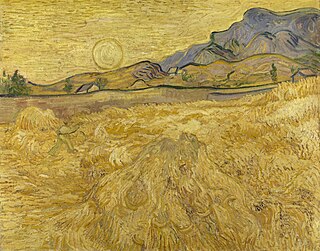
Reaper, Wheat Field with Reaper, or Wheat Field with Reaper and Sun is the title given to each of a series of three oil-on-canvas paintings by Vincent van Gogh of a man reaping a wheat field under a bright early-morning sun. To the artist, the reaper represented death and "humanity would be the wheat being reaped". However, Van Gogh did not consider the work to be sad but "almost smiling" and taking "place in broad daylight with a sun that floods everything with a light of fine gold".
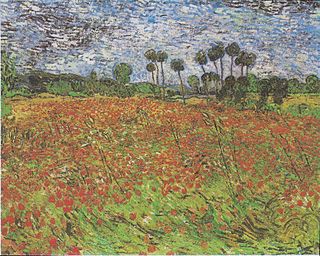
Poppy Field is an 1890 painting by the Dutch artist Vincent van Gogh, painted around a month before his death during his stay in Auvers-sur-Oise, France. It has been described as "a composition that verges on the abstract" and shows marked difference from a 1888 painting of the same subject that now is in the Van Gogh Museum, in Amsterdam. Spending many years in Germany, the painting now hangs in the Kunstmuseum, in The Hague.
